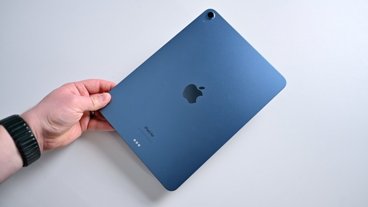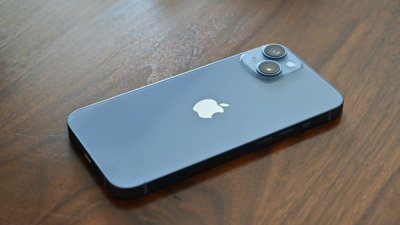Notes of interest for Apple's Q1 2009 financial results call
Apple is holding a conference call to discuss the results of its first fiscal quarter for 2009, a record quarter for earnings and revenues despite a much harsher world economy. Notes for its performance during the quarter and for the call follow.
Apple regional business segments
Apple Americas accounted for 912,000 Mac shipments and $4.5 billion in revenues. These figures are up 8 percent and 5 percent year-over-year, respectively. Sequentially, shipments were down a sharp 19 percent, though revenue increased a dramatic 26 percent.
Apple Europe accounted for 795,000 Mac shipments and $2.77 billion in revenues. Both these figures were up 13 percent and 12 percent year-over-year, and climbed even further sequentially by 30 and 61 percent.
Apple Japan accounted for a small 99,000 Mac shipments and $481 million in revenues, though these were increases of 9 and 20 percent year-over-year and sequential boosts of 27 percent for units and 50 percent in revenue.
Apple's Asia Pacific (and FileMaker Inc), billed as "Other Segments," accounted for 203,000 Mac shipments and $674 million in revenues. These figures are up by 14 percent in units from year to year but down 9 percent in revenue. Sequentially, unit shipments are near-flat with a 1 percent decline, albeit accompanied by a 20 percent lift in revenue.
Apple's "Other Music Related Products and Services" segment accounted for $1.01 billion in revenue, representing a large 25 percent increase year-over-year and 22 percent sequentially.
Apple's "Peripherals and Other Hardware" added $378 million in revenue, generating 1 percent less in revenue year-over-year and 12 percent less compared to the past quarter.
Apple's "Software, Service and Other Sales" segment provided $606 million in revenue, sinking 4 percent versus the same point in calendar 2007 but standing as a 10 percent climb over the previous quarter.
Apple's Mac business
Apple sold 2.524 million Macs in the period, which is 9 percent more than it managed a year earlier.
Of those Macs, 728,000 were desktops and 1.796 million were notebooks; while the desktop figure is a 25 percent drop in units versus the end of 2007 and a 31 percent dip in revenue, notebooks surged 34 percent in units and 23 percent in revenue. Sequentially, desktops also fell with 22 and 23 percent drops in units and revenue, but notebooks expanded by 7 and 11 percent in these two categories.
Macs accounted for just over a third of Apple's total revenue at 34.96 percent. Even so, Macs accounted for the largest individual portion of the company's sales.
Customer response to the new MacBook and MacBook Pro is "very strong."
Explaining the iMac drop, the company says that this reflects a shift towards portables and notes that IDC stats saw a 16 percent shrink in the world desktop market during the last quarter.
iLife and iWork '09 updates should help differentiate Apple's computers.
There were about 3 weeks of Mac channel inventory.
Mac Pros make up a "small percentage" of Apple's desktop business (the company has long since dropped per-model shipment breakdowns).
On netbooks: these have slow processors, cramped keyboards and small displays; they give users experiences that they aren't necessarily happy with. Apple is watching the space and has its ideas but won't jump in with current conditions.
Apple is down 6 percent in the educational market year-over-year, and 12 percent specifically in K-12. The economy directly contributes to the poorer results.
Apple's Apple TV and iPhone businesses
Apple sold 4,363,000 iPhones during the quarter and earned about $1.25 billion from these and related products over the quarter; while not as high as this past summer's iPhone 3G launch numbers of roughly 6.9 million units, it represents 88 percent growth in units and a massive 417 percent increase in revenue compared to the year-ago quarter. Compared to the last quarter, units dropped 37 percent but were countered by a 55 percent jump in revenue.
Apple sells the iPhone in 70 countries as of the end of 2008.
On whether iPhone pricing is flexible: while the market is "clearly elastic" and Apple has dropped prices from $399 to $199, the current price is a "compelling value" and nothing in the market competes close enough to this. Apple believes itself "years ahead" in software as well.
Apple isn't going to play in the low-end voice phone market. Apple is interested in making the best phone, not selling the most units.
iPhone channel inventory was disproportionately lower than the decrease in sales versus the summer, as Apple has about 1 million phones versus 2 million before.
Apple is "constantly evaluating" the best way to operate in current and future iPhone-carrying countries.
It's impossible to say how much Walmart will contribute to the iPhone as it only launched the device in late December. However, it reaches many more people with over 4,000 stores, including in areas where no Apple stores are available or what AT&T could handle. The decision to sign Walmart for iPhone distribution was based on iPod results.
Apple will continue to invest in Apple TV and says it has received a "tremendous tickup" in performance thanks in part to iTunes rentals. Unit sales, though unpublished, are 3 times higher than they were in late 2007. The device holds promise for the future but is still a "hobby."
Regarding the Palm Pre, which many see as a very similar device to the iPhone: Apple is ready to suit up and go against anyone. It's difficult to judge products that aren't in the market yet, too. Software is the key ingredient, and developers don't always want to develop apps for every type of device. When it comes to similarity, Apple doesn't imply that Palm is stealing multi-touch technology or any other features and doesn't want to talk about any specific company that might, but always likes competition as long as it doesn't rip off its intellectual property.
Apple's retail business
Apple's retail stores combined to sell 515,000 Mac units and generate $1.74 billion in revenues during Apple's first fiscal quarter, marking yearly growth of 2 percent each in units and revenue. Sequentially, retail sales tumbled 14 percent in units but grew 1 percent in revenue.
"Almost half" of all Macs sold at retail were to those new to Apple computers.
Retail stores are in 10 countries. The first German store is off to a great start. There are 251 stores total.
Average revenue per store was $7 million, down from $8.5 million a year earlier; there were 46.7 million visitors for all stores.
Apple plans to open 25 stores in its fiscal 2009, about half of which will be outside the US. The company will be "selective" in what stores it opens.
The shops are considered a place to experience Apple's devices, not just to sell them; the company is "fine" with it if customers ultimately come in but choose to buy online or at other stores.
Retailers did do heavy promotional campaigns in the holidays, particularly with iPods, but they're free to do it and haven't done so in January.
Apple's iPod and iTunes businesses
About 22,727,000 iPods were shipped this quarter; the number is an all-time record for Apple. The unit shipments climbed 3 percent year-over-year, but revenues dropped by 16 percent. Sequential results saw a 106 percent improvement in unit numbers and 103 percent in sheer revenue.
There are 4-6 weeks of channel inventory.
Biggest quarter ever for iTunes thanks to music, video and App Store sales, especially on Christmas Day and Christmas week.
There are over 15,000 apps in the store.
Apple has 73 percent of the MP3 player market in the US and is gaining elsewhere, with 70 percent in the UK and Australia, 60 percent in Japan, 50 percent in Canada and gains in smaller markets like France, Italy and Spain.
All growth in iPod sales was international; expectedly, most of the growth came in the last few weeks from holiday sales.
The financial side of Q4
Apple collected a total of $10.17 billion in revenue during the first fiscal quarter; it's the first time the company has crested $10 billion in a quarter.
Gross margins were low at 20.9 percent due to higher than expected costs, though the company did warn in its previous quarter's results that margins would drop.
Outside of GAAP accounting measures, Apple says it earned $11.8 billion in revenue and $2.3 billion in profit.
The company added another $3.6 billion in cash during the quarter to have a total of $28.1 billion.
Operational expenses were $1.4 billion, while cash flow from operations is over $3.9 billion.
Apple is "extremely proud of this very solid growth" compared to the rest of the market, which has been declining.
Apple's next fiscal quarter (Q109)
Apple expects earnings per share between $0.90 to $1. The guidance is narrower than it was last quarter but is still wide because the company's visibility in the public isn't as strong as it has been. Recurring business and a strong product line give Apple confidence it will continue to do relatively well, and the economy isn't as volatile as it was when the company reported results in October.
Margins should climb back up to 32.5 percent thanks to $28 million in stock-based compensation. It's a decline from the year before but reflects the stronger influence of the US dollar, favorable settlements, and lower revenue. There should be $150 million in stock-based compensation. The tax rate will be about 31 percent.
In the second half of the fiscal year, margins are estimated to hover at 30 percent. A further strengthening of the dollar is likely to affect the company.
As for Steve Jobs: there is "extraordinary depth" in the Apple executive team, and the values of the company are "extremely well-entrenched." Jobs will make major strategy decisions while Tim Cook (as acting CEO) will handle the day-to-day operations during Jobs' absence. Apple's willingness to say "no" to many ideas and to insist on a particular standard are deeply ingrained enough that Apple will continue to do "extremely well."
Continue to focus on offering devices with features that can't be matched at the prices and that there will be no price umbrellas that let rivals sneak in.
Apple believes component costs aren't likely to decrease in the ongoing quarter, where they did last quarter; they were at or near their variable costs and so had little room to budge. However, Apple expects an overall favorable environment both in supply and in prices for things like RAM, flash memory, displays and other technology.
No predictions are being given externally on whether or not Apple can beat the usual, seasonal drop in cellphone sales in early calendar 2009. The main concern is that a poor overall market may discourage customers from adopting smartphones due to their more expensive service plans. Apple is still confident its product pipeline will help.
Additional coverage of Apple's Q109 release
 Katie Marsal
Katie Marsal










 Andrew Orr
Andrew Orr
 Malcolm Owen
Malcolm Owen

 William Gallagher
William Gallagher

 Mike Wuerthele
Mike Wuerthele
 Christine McKee
Christine McKee








